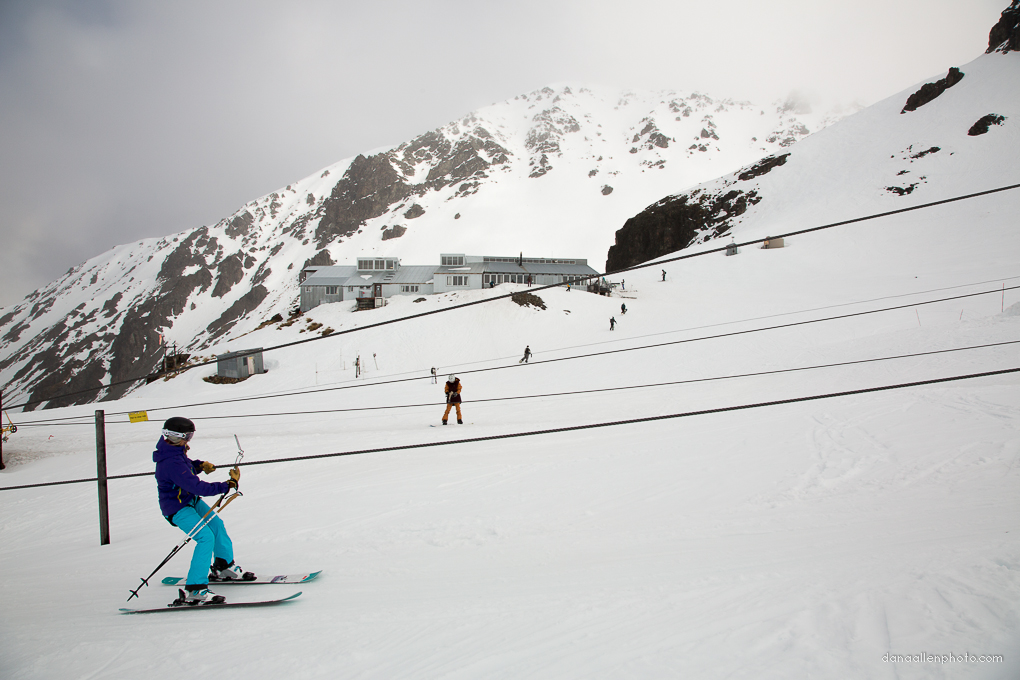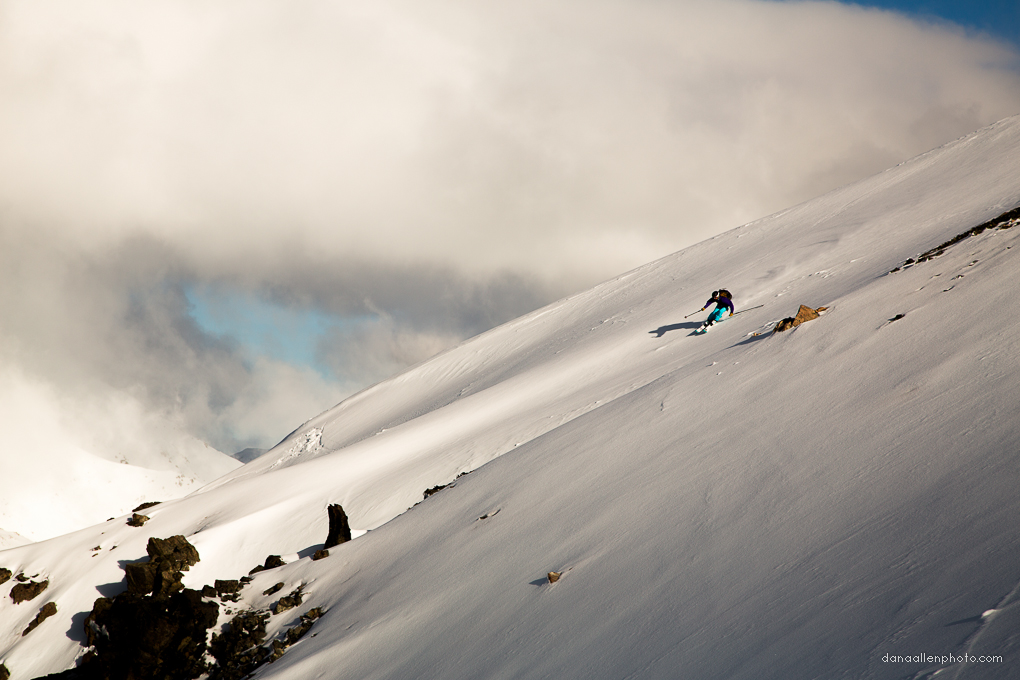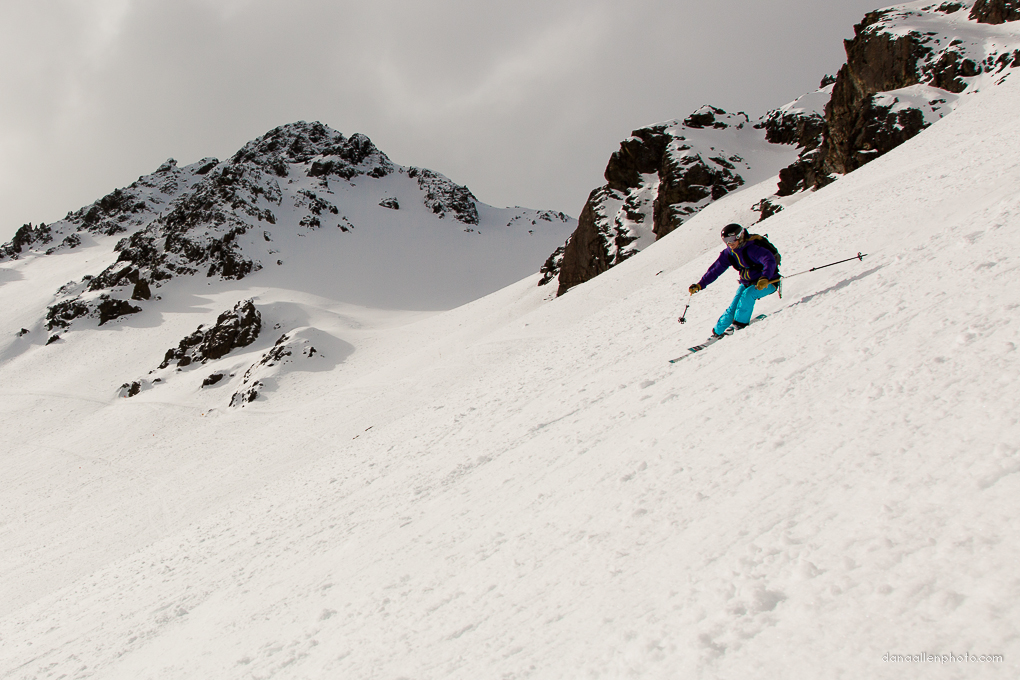
Ski: 2015-2016 Rossignol Savory 7, 170cm
Dimensions (mm): 136-106-126
Sidecut Radius: 17 meters (178cm)
Actual Tip-to-Tail Length (Straight Tape Pull): 169.5cm
Boots / Bindings: Shiva MX / Rossignol Axial 120 (DIN at 8)
Mount Location: Recommended Line
Days Skied: 5
Test Locations: Craigieburn Valley, Mt. Olympus, and Broken River club fields, New Zealand
[Editor’s Note: Our review was conducted on the 13/14 Savory 7, which is unchanged for 14/15 and 15/16, except for the graphics.]
For the 2013-2014 season, Rossignol has introduced the Savory 7 into its women’s freeski lineup. Rossi describes it as “a revolutionary fusion of backcountry, freestyle, and freeride performance…the most versatile women’s freeride ski we’ve ever designed.”
The Savory 7 fills a previously unoccupied niche in the 104-107mm underfoot category, and will be joined by the larger Star 7 (116mm) and the smaller Saffron 7 (98mm) and Sassy 7 (90mm). The Savory 7 and Rossi’s Soul 7 are the same ski with different topsheets, and you can read our review of the 188cm Soul 7 to get our take on a longer length of this ski.
Since its release last January, the Savory 7 has received a lot of positive attention, and I’d been excited to get on it. After two seasons in Colorado with relatively low snowfall, I have been increasingly interested in narrower skis in the 104-107mm range over a wider, versatile powder ski, like the 113mm Nordica La Niña. The Savory 7’s construction and dimensions make it a light, playful daily driver in both the resort and backcountry, which seemed to fit the bill for my inbound and backcountry days in the Colorado Rockies.
Soft Variable Snow
My first day on the Savory 7 was in soft, spring-like conditions at the Mt. Olympus club field. Most of the ski club fields in Canterbury, New Zealand are unique in that they don’t have any chairlifts; rather, they have rope tow lines that operate on a simple pulley system. I was not able to make an initial judgment of the ski’s swing weight on the first chair of the day, but instead had to figure out how to attach my metal nutcracker to the swiftly moving rope.

After a moment of uncoordinated struggling, I was awkwardly on my way up the Mt. Olympus tow, and happy that the Savory 7 felt light, not cumbersome.
For the first few runs, I lapped the traverse-accessed Parsons Dollar and Back Run. As the day wore on, the sun warmed up most aspects of the mountain and the trails were a mix of untouched and tracked out wet snow.
Dropping in off the traverses, I pointed my skis and arced my way back to the tow. The Savory 7 felt awesome. The ski carved through the soft snow with no resistance, and turns were effortless to initiate. Especially through the smoother sections, I felt comfortable bringing the Savory 7 up to high speeds, and could easily dig the ski deep into a carve. In this snow, the ski was just as happy to smear turns as it was to carve.
I mentioned above that one of my initial impressions of the Savory 7 was that it felt extremely light—this is not a heavy, damp ski. But I didn’t find the low weight of the ski to necessarily translate into a soft ski. I had no trouble alternating between fast, aggressive turns with strong outside ski pressure, and lighter, quick small-radius turns.
The surfy, playful nature of the Savory 7 was unlike many of the skis I have ridden in the last several seasons. Although I haven’t skied the Rossignol S3W in two winters, the Savory 7 has a similar, poppy response on consistent snow, with a stiffer flex and more stability. The Nordica La Nina is another lively ski that performs great in both soft snow and on groomers. The Savory 7 can’t be skied quite as hard as the La Nina in most conditions, but provides a lighter, jibby ride.

For most of the morning and early afternoon, the snow conditions stayed consistently soft and spring-like. The area below the top rope tow, called Frozen Waves, featured fun wind lips and rollovers. The Savory 7 felt well balanced and intuitive in the air, even with direction changes, and it had enough tail for solid landings most of the time. (Landing drops with a steeper, hardpacked runout, the Savory 7 was a little squirrely, though I think a longer length ski would have added more stability.) The playful nature of the ski made small bumps a blast to carve around or blow through, and I was constantly seeking out jumps and drops.
As the day wore on, the snow heated up to a thick, heavy consistency. We decided to bootpack up a section of the Back Ridge called Little Alaska, which has numerous short, steep couloirs off the top. The shaded upper section skied well and hop turns were exceptionally easy to make, especially on the shorter length ski (I generally ride a longer ski, but will touch on that in more detail later).
Crossing into the sun-affected lower half of the basin, however, was where things started to get a little rough. As I exited the choke and began to make big, fast turns, the Savory 7’s tails felt grabby through the baked snow littered with wetslide debris.
Although most tails with low profile rocker would catch in these conditions, the tips didn’t cut through the thick snow as well as I had hoped. I fared a little better when I slowed down and pressured the ski harder, but as I watched the other skiers cruise through the same section, I began to worry that I would encounter more problems in variable, hard snow too.
Firm Variable Snow
After a freezing cycle that didn’t unfreeze, the next day offered up some tricky snow conditions: all tracks, divets, and sluffball chunks were frozen solid. At slow to medium speeds, the lightness of the Savory 7 didn’t create too much of an issue, since I could pick my way over and through the ruts. But once I started making faster turns, the firm chunder would deflect my tips and cause the skis to bounce over the snow, rather than cut into it. This resulted in somewhat erratic behavior of the skis, which forced me to keep slowing down. Despite this, I found the Savory 7 quite forgiving when I did get bucked around, and could easily ditch speed or make a move forward to regain control.
I should note here that I tend to ski fast and aggressively with a forward stance, which isn’t every skier’s style. If you’re primarily looking for a ski that can charge hard in crud, I would suggest looking into other options, such as the Moment Bella, Blizzard Dakota, or Nordica Wildfire. For those who aren’t looking to pin it down hard chop, the Savory 7 will likely work for you, and might be easier to maneuver than these other skis through variable snow.


Hello,
I am going to buy skis similar to these. They are the Saffron 7 from Rossi — 98mm underfoot but a similar rocker ski. I am 5’8″ 143lbs Intermediate-Advanced Vermont skier and am deciding between the 170cm and 178 cm. What length would you recommend?
Thanks,
Linnea
Hi!
Wondering what size you ended up getting? I am 5’6″ and 132 lbs…am wondering if 175’s will be too long?
Thanks!
Hi Becki!
What would you say your level of skiing is? I would also consider where you spend most of your time skiing. I think that if you are a stronger, more aggressive skier you would be ok with a longer length. Although I do believe it’s a 178, not a 175…I think that the Savory 7 is a more manageable 178cm ski, but if you want to do a lot of tree skiing, ski in moguls often, or prefer making quicker, shorter radius turns, the 170 could be a better bet. Let me know if you have any additional questions and I hope this helps!
Julia
another size question…
My 22 yo daughter is 5″7″ 140 lbs and a strong skier – on blacks mostly out west. Good on steep and in the deep and in trees. Shes still trying to get her timing down in big bumps . Likes to turn more than ski flat out. But relegated to skiing harder snow in the east. Hope to start to get her out into side and back country. What size would you recommend as a good compromize between manuverability and some stability. 162cm or 170?
Thanks